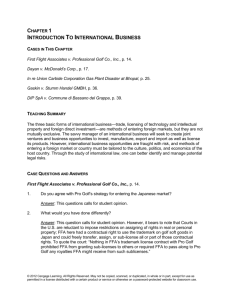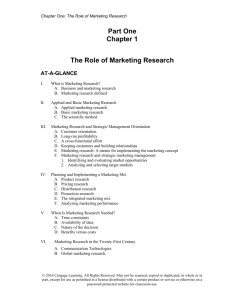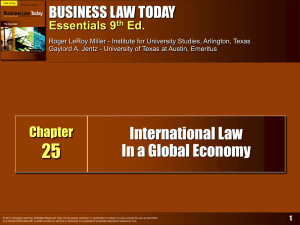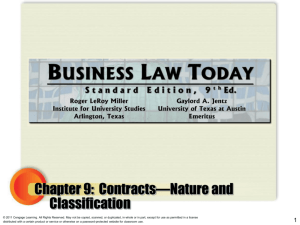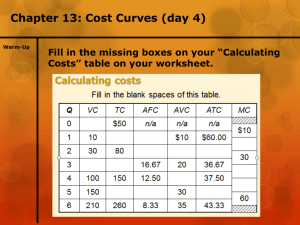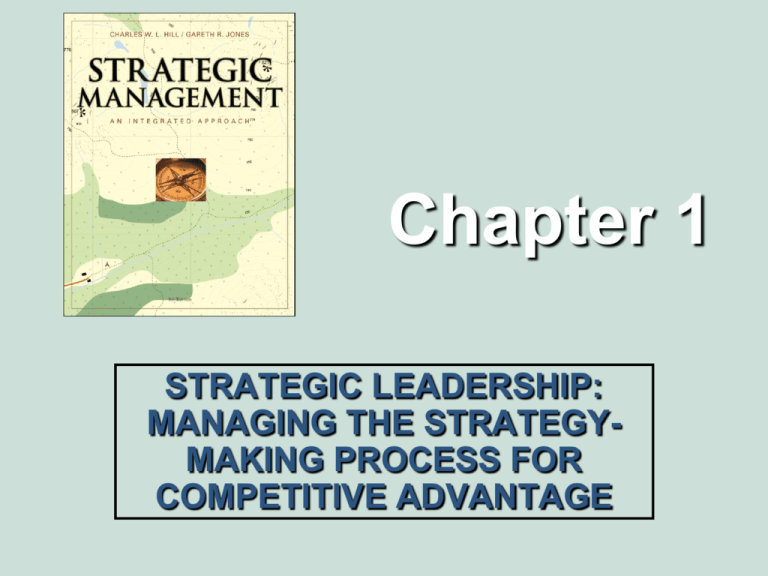
Chapter 1
STRATEGIC LEADERSHIP:
MANAGING THE STRATEGYMAKING PROCESS FOR
COMPETITIVE ADVANTAGE
Learning Objectives
• Explain “competitive advantage”
• Discuss strategic role of managers at
different levels of organization
• Identify steps in strategic planning process
• Discuss pitfalls of planning and how they
can be avoided
• Identify cognitive biases that lead to poor
strategic decisions & explain how they can
be avoided
• Discuss role of strategic leaders in the
strategy-making process
2010 Cengage Learning. All Rights Reserved. May not be copied, scanned, or duplicated, in whole or in part, except for use as
permitted in a license distributed with a certain product or service or otherwise on a password-protected website for classroom use.
1-2
“If you don’t have a strategy you
will be . . . part of somebody
else’s strategy.”
- Alvin Toffler
2010 Cengage Learning. All Rights Reserved. May not be copied, scanned, or duplicated, in whole or in part, except for use as
permitted in a license distributed with a certain product or service or otherwise on a password-protected website for classroom use.
1-3
Profitability of
Walmart & Competitors
Figure 1.1
2010 Cengage Learning. All Rights Reserved. May not be copied, scanned, or duplicated, in whole or in part, except for use as
permitted in a license distributed with a certain product or service or otherwise on a password-protected website for classroom use.
1-4
Why do some organizations
succeed while others fail?
Strategy- a set of related actions managers take
to increase company’s performance.
o Strategic Leadership- Effectively managing
a company’s strategy-making process
o Strategy Formulation- Determining &
selecting strategies
o Strategy Implementation- Putting strategies
into action to improve company’s efficiency
& effectiveness
2010 Cengage Learning. All Rights Reserved. May not be copied, scanned, or duplicated, in whole or in part, except for use as
permitted in a license distributed with a certain product or service or otherwise on a password-protected website for classroom use.
1-5
Determinants of
Shareholder Value
Figure 1.2
To increase shareholder value, managers must
pursue strategies that increase the profitability
of the company and grow the profits.
2010 Cengage Learning. All Rights Reserved. May not be copied, scanned, or duplicated, in whole or in part, except for use as
permitted in a license distributed with a certain product or service or otherwise on a password-protected website for classroom use.
1-6
Superior Performance
“Maximizing shareholder
value is the ultimate
goal of profit making
companies…”
2010 Cengage Learning. All Rights Reserved. May not be copied, scanned, or duplicated, in whole or in part, except for use as
permitted in a license distributed with a certain product or service or otherwise on a password-protected website for classroom use.
1-7
Competitive Advantage
“…results when a
company’s strategies
lead to superior
performance compared
to competitors
2010 Cengage Learning. All Rights Reserved. May not be copied, scanned, or duplicated, in whole or in part, except for use as
permitted in a license distributed with a certain product or service or otherwise on a password-protected website for classroom use.
1-8
Sustained
Competitive Advantage
“A company’s…
strategies enable it to
maintain above
average profitability for
a number of years.”
2010 Cengage Learning. All Rights Reserved. May not be copied, scanned, or duplicated, in whole or in part, except for use as
permitted in a license distributed with a certain product or service or otherwise on a password-protected website for classroom use.
1-9
Company’s Business Model
“…a conception of how a set of strategies…mesh… (to)
allow… company to gain competitive advantage and
achieve superior profitability…
Encompasses how the company will:
•
•
•
•
•
•
Select customers
Define/differentiate
product offerings
Create value for
customers
Acquire/keep customers
Produce goods/services
Lower costs
•
•
•
•
•
Deliver goods/services to
market
Organize activities within
company
Configure its resources
Achieve/sustain a high
profitability
Grow business over time
2010 Cengage Learning. All Rights Reserved. May not be copied, scanned, or duplicated, in whole or in part, except for use as
permitted in a license distributed with a certain product or service or otherwise on a password-protected website for classroom use.
1-10
Differences in
Industry Performance
Profitability/Profit Growth:
Overall performance
of industry relative
to other industries
Company’s relative success
in industry compared to
competitors
2010 Cengage Learning. All Rights Reserved. May not be copied, scanned, or duplicated, in whole or in part, except for use as
permitted in a license distributed with a certain product or service or otherwise on a password-protected website for classroom use.
1-11
ROI in Selected Industries
(2004–2008)
Figure 1.3
2010 Cengage Learning. All Rights Reserved. May not be copied, scanned, or duplicated, in whole or in part, except for use as
permitted in a license distributed with a certain product or service or otherwise on a password-protected website for classroom use.
1-12
Performance in
Nonprofit Enterprises
Nonprofit entities= government
agencies, universities, charities:
o Not in business to make a profit
o Still need to use resources efficiently &
effectively
o Must meet goals
o Set strategies to achieve goals and
compete with other nonprofits for scarce
resources
2010 Cengage Learning. All Rights Reserved. May not be copied, scanned, or duplicated, in whole or in part, except for use as
permitted in a license distributed with a certain product or service or otherwise on a password-protected website for classroom use.
1-13
“A successful strategy
gives potential donors a
compelling message
about why they should
contribute.”
2010 Cengage Learning. All Rights Reserved. May not be copied, scanned, or duplicated, in whole or in part, except for use as
permitted in a license distributed with a certain product or service or otherwise on a password-protected website for classroom use.
1-14
Strategic Managers
o Corporate-Level Managers
o Oversee development of strategies for whole
organization
o CEO is principle general manager who consults with
other senior executives
o Business-Level Managers
o Responsible for business unit that provides
product/service to particular market
o Functional-Managers
o Supervise particular function/operation (e.g.
marketing, operations, accounting, human resources)
2010 Cengage Learning. All Rights Reserved. May not be copied, scanned, or duplicated, in whole or in part, except for use as
permitted in a license distributed with a certain product or service or otherwise on a password-protected website for classroom use.
1-15
Levels of
Strategic Management
Figure 1.4
2010 Cengage Learning. All Rights Reserved. May not be copied, scanned, or duplicated, in whole or in part, except for use as
permitted in a license distributed with a certain product or service or otherwise on a password-protected website for classroom use.
1-16
Strategy-Making Process
Select corporate mission & major corporate
goals.
Analyze external competitive environment to
identify opportunities/threats.
Analyze organization’s internal environment to
identify strengths/weaknesses.
Select strategies that:
•
•
•
Build on organization’s strengths and correct weaknesses– to
take advantage of external opportunities & counter external
threats
Are consistent with organization’s mission and major goals
Are congruent and constitute a viable business model
Implement the strategies.
2010 Cengage Learning. All Rights Reserved. May not be copied, scanned, or duplicated, in whole or in part, except for use as
permitted in a license distributed with a certain product or service or otherwise on a password-protected website for classroom use.
1-17
Strategy Formulation
& Implementation
Figure 1.5
2010 Cengage Learning. All Rights Reserved. May not be copied, scanned, or duplicated, in whole or in part, except for use as
permitted in a license distributed with a certain product or service or otherwise on a password-protected website for classroom use.
1-18
Mission Statement
Provides framework within
which strategies are formulated:
o Mission – Reason for existence – what an
o
o
o
organization does
Vision – Some desired future state
Values – Key values an organization is
committed to
Major Goals – Measurable desired future
state an organization attempts to realize
2010 Cengage Learning. All Rights Reserved. May not be copied, scanned, or duplicated, in whole or in part, except for use as
permitted in a license distributed with a certain product or service or otherwise on a password-protected website for classroom use.
1-19
The Mission
o What is it the company does?
Who is being satisfied- What customer
groups?
What is being satisfied- What customer
needs?
How customer needs are being satisfied- by
what skills, knowledge, or distinctive
competencies?
A company’s mission is best approached from
a customer-oriented business definition.
2010 Cengage Learning. All Rights Reserved. May not be copied, scanned, or duplicated, in whole or in part, except for use as
permitted in a license distributed with a certain product or service or otherwise on a password-protected website for classroom use.
1-20
Defining the Business
Figure 1.6
Source: D. F. Abell, Defining the Business: The Starting Point of Strategic Planning (Englewood Cliffs, Prentice Hall, 1980), p. 7.
2010 Cengage Learning. All Rights Reserved. May not be copied, scanned, or duplicated, in whole or in part, except for use as
permitted in a license distributed with a certain product or service or otherwise on a password-protected website for classroom use.
1-21
The Vision
What would company like to achieve?
A good vision is meant to stretch a company by
articulating an ambitious but attainable future state.
Nokia is the world’s largest manufacturer of
mobile phones and operates with a simple
but powerful vision: “If it can go mobile, it
will!”
2010 Cengage Learning. All Rights Reserved. May not be copied, scanned, or duplicated, in whole or in part, except for use as
permitted in a license distributed with a certain product or service or otherwise on a password-protected website for classroom use.
1-22
Values
o How managers and employees should
conduct themselves
o How they should do business
o What kind of organization they need to
build to help achieve company’s
mission
o Organizational culture
• Set of values, norms, and standards that control
how employees work to achieve organization’s
mission and goals
• Often seen as an important source of competitive
advantage
2010 Cengage Learning. All Rights Reserved. May not be copied, scanned, or duplicated, in whole or in part, except for use as
permitted in a license distributed with a certain product or service or otherwise on a password-protected website for classroom use.
1-23
In high-performance
organizations, values
respect the interests
of key stakeholders.
2010 Cengage Learning. All Rights Reserved. May not be copied, scanned, or duplicated, in whole or in part, except for use as
permitted in a license distributed with a certain product or service or otherwise on a password-protected website for classroom use.
1-24
Values at Nucor
“Management is obligated to manage Nucor in such
a way that employees will have the opportunity to
earn according to their productivity.”
“Employees should be able to feel confident that if
they do their jobs properly, they will have a job
tomorrow.”
“Employees have the right to be treated fairly and
must believe that they will be.”
“Employees must have an avenue of appeal when
they believe they are being treated unfairly.”
2010 Cengage Learning. All Rights Reserved. May not be copied, scanned, or duplicated, in whole or in part, except for use as
permitted in a license distributed with a certain product or service or otherwise on a password-protected website for classroom use.
1-25
Major Goals
Goal - precise/measurable desired future
state a company attempts to realize.
Well-constructed goals:
1.
Precise and measurable– provide yardstick or
standard to judge performance
2.
Address crucial issues– a limited number of key
goals helps maintain focus
3.
Challenging but realistic– provide
employees with
incentive for improving
4.
Specify time period– motivates/injects sense of
urgency into goal attainment
2010 Cengage Learning. All Rights Reserved. May not be copied, scanned, or duplicated, in whole or in part, except for use as
permitted in a license distributed with a certain product or service or otherwise on a password-protected website for classroom use.
1-26
External Analysis
Identifies strategic
opportunities & threats in
organization’s operating
environment that will affect
how it pursues its mission.
2010 Cengage Learning. All Rights Reserved. May not be copied, scanned, or duplicated, in whole or in part, except for use as
permitted in a license distributed with a certain product or service or otherwise on a password-protected website for classroom use.
1-27
External Analysis
Requires assessment of:
o Industry environment
o Competitive structure of industry
o Competitive position of the company
o Competitiveness and position of major rivals
o Country/national environments in which
company competes
o Wider socioeconomic/macroenvironment
that may affect company and its industry
• Social
• Legal
• Governmental • International • Technological
2010 Cengage Learning. All Rights Reserved. May not be copied, scanned, or duplicated, in whole or in part, except for use as
permitted in a license distributed with a certain product or service or otherwise on a password-protected website for classroom use.
1-28
Internal Analysis
Strengths= superior performance
Weaknesses= inferior performance.
Includes review of:
Company’s resources &
capabilities
Company-specific
competencies
2010 Cengage Learning. All Rights Reserved. May not be copied, scanned, or duplicated, in whole or in part, except for use as
permitted in a license distributed with a certain product or service or otherwise on a password-protected website for classroom use.
1-29
SWOT Analysis
and Business Model
o SWOT analyses identifies strategies that align
company resources/capabilities to environment
to create/sustain competitive advantage.
o Functional strategies should be consistent with
& support company business level/global
strategies.
o Functional-level strategy – directed at operational
effectiveness
o Business-level strategy – overall competitive theme
o Global strategy – expand/grow/prosper at global level
o Corporate-level strategy – maximize profitability &
profit growth
2010 Cengage Learning. All Rights Reserved. May not be copied, scanned, or duplicated, in whole or in part, except for use as
permitted in a license distributed with a certain product or service or otherwise on a password-protected website for classroom use.
1-30
Strategy Implementation
Managers put strategies into action:
o Implementation/execution of strategic
plans
o Design best organization structure,
culture, control systems
o Governance system for legal/ethical
compliance
o Consistency with maximizing profit &
profit growth
2010 Cengage Learning. All Rights Reserved. May not be copied, scanned, or duplicated, in whole or in part, except for use as
permitted in a license distributed with a certain product or service or otherwise on a password-protected website for classroom use.
1-31
⑥The Feedback Loop
Strategic planning is ongoing.
Monitor strategy execution:
Determine strategic goals/objectives being
achieved
Evaluate competitive advantage is being
created & sustained
Monitor/reevaluate for the next round
of strategy formulation/implementation
2010 Cengage Learning. All Rights Reserved. May not be copied, scanned, or duplicated, in whole or in part, except for use as
permitted in a license distributed with a certain product or service or otherwise on a password-protected website for classroom use.
1-32
Criticisms of
Formal Planning Model
1) Unpredictability of real world
2) Role lower-level
managers can play
3) Many strategies
result of serendipity
2010 Cengage Learning. All Rights Reserved. May not be copied, scanned, or duplicated, in whole or in part, except for use as
permitted in a license distributed with a certain product or service or otherwise on a password-protected website for classroom use.
1-33
Intended & Emergent Strategies
o Intended/Planned Strategies
o Strategies organization plans to implement
o Result of formal planning process
o Unrealized strategies are unprecedented changes &
unplanned events after formal planning complete
o Emergent Strategies
o Unplanned responses to unforeseen circumstances
o Serendipitous discoveries/events emerge that open
up unplanned opportunities
o Assess emergent strategy fits needs & capabilities
o Realized Strategies
o Intended strategies put into action & emergent
strategies evolve
2010 Cengage Learning. All Rights Reserved. May not be copied, scanned, or duplicated, in whole or in part, except for use as
permitted in a license distributed with a certain product or service or otherwise on a password-protected website for classroom use.
1-34
Emergent &
Deliberate Strategies
Figure 1.7
Source: Adapted from H. Mintzberg and A. McGugh, Administrative Science Quarterly, Vol. 30. No. 2, June 1985.
2010 Cengage Learning. All Rights Reserved. May not be copied, scanned, or duplicated, in whole or in part, except for use as
permitted in a license distributed with a certain product or service or otherwise on a password-protected website for classroom use.
1-35
Strategic Planning in Practice
Formal planning has positive impact on performanceshould include current/future competitive environments.
o Scenario Planning
• Recognizes the future unpredictable
• Develops strategies for future scenarios
o Decentralized Planning- Functional
managers
• Avoids ivory tower approach
• Corporate-level planners = facilitators
2010 Cengage Learning. All Rights Reserved. May not be copied, scanned, or duplicated, in whole or in part, except for use as
permitted in a license distributed with a certain product or service or otherwise on a password-protected website for classroom use.
1-36
Scenario Planning
Figure 1.8
Data Source: Value Line Investment Survey
2010 Cengage Learning. All Rights Reserved. May not be copied, scanned, or duplicated, in whole or in part, except for use as
permitted in a license distributed with a certain product or service or otherwise on a password-protected website for classroom use.
1-37
Strategic Decision Making
Companies may adopt poor strategies if
groupthink or individual cognitive biases allowed
to intrude into decision-making process.
Cognitive biases: Rules of thumb
result in errors
Groupthink: Decision makers
embark on course of action without
questioning underlying assumptions
2010 Cengage Learning. All Rights Reserved. May not be copied, scanned, or duplicated, in whole or in part, except for use as
permitted in a license distributed with a certain product or service or otherwise on a password-protected website for classroom use.
1-38
Strategic Leadership
Good leaders of strategy-making
process have key attributes:
Vision, eloquence, and consistency
Articulation of business model
Commitment
Well informed
Willing to delegate or
empower
Astute use of power
Emotional intelligence
2010 Cengage Learning. All Rights Reserved. May not be copied, scanned, or duplicated, in whole or in part, except for use as
permitted in a license distributed with a certain product or service or otherwise on a password-protected website for classroom use.
1-39
“The essence of strategy lies
in creating tomorrow’s
competitive advantage faster
than competitors mimic the
ones you possess today.”
- Gary Hamel & C. K. Prahalad
2010 Cengage Learning. All Rights Reserved. May not be copied, scanned, or duplicated, in whole or in part, except for use as
permitted in a license distributed with a certain product or service or otherwise on a password-protected website for classroom use.
1-40




